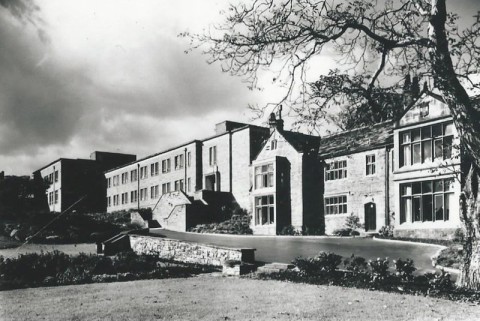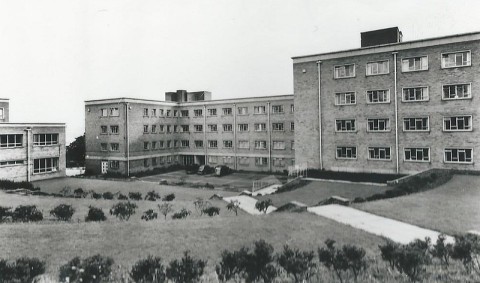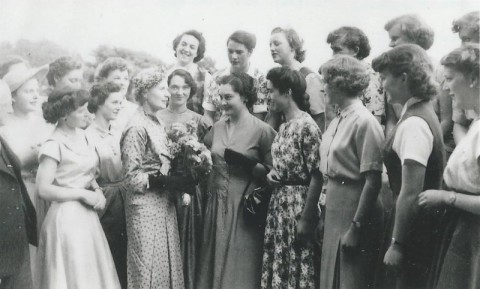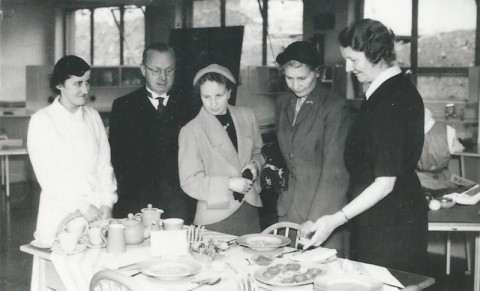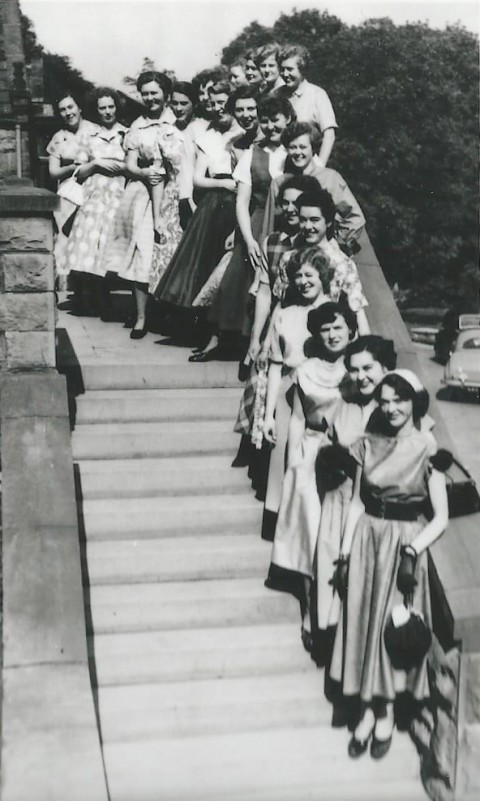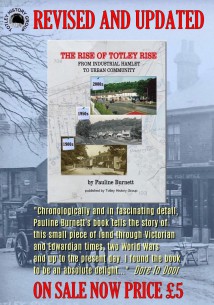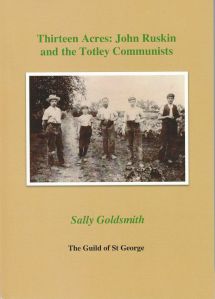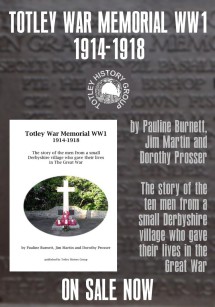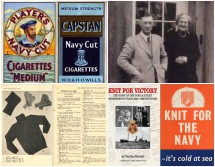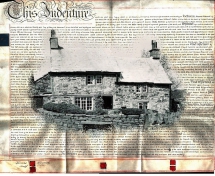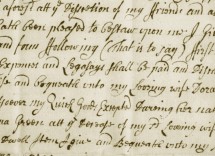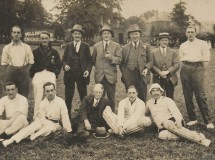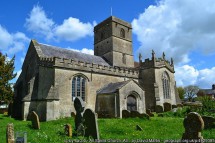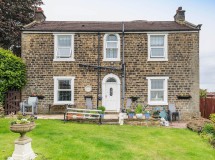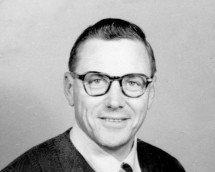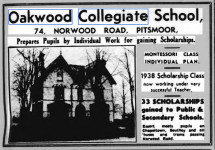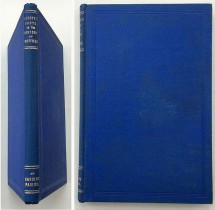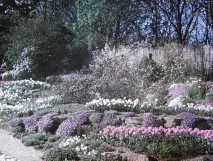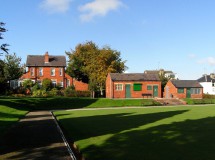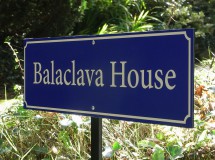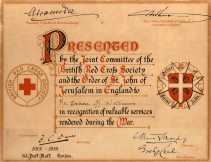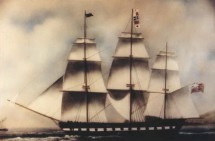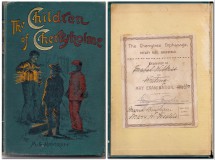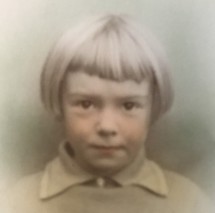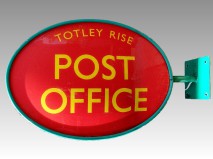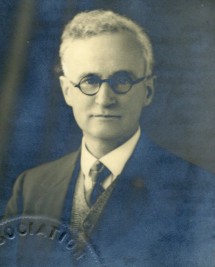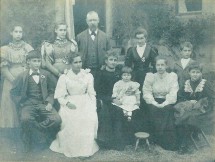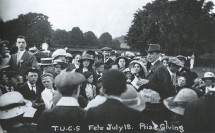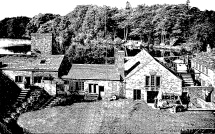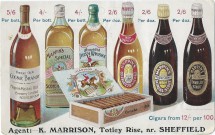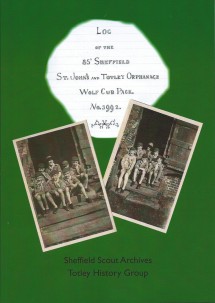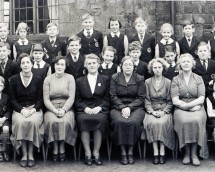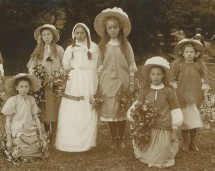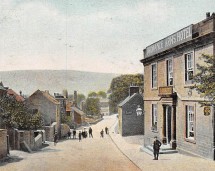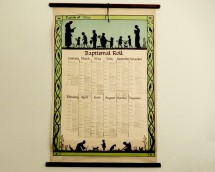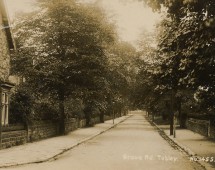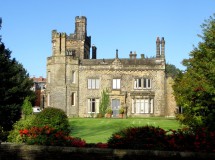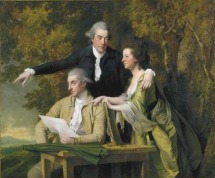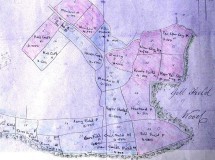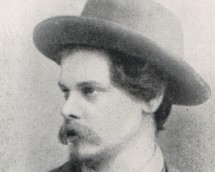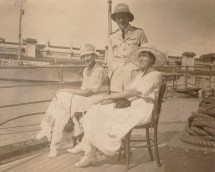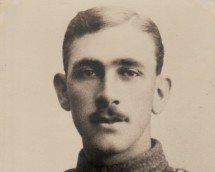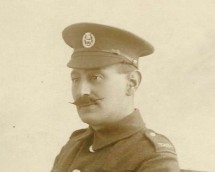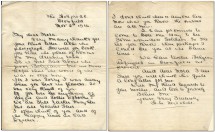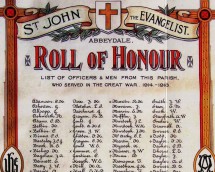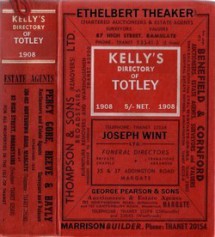Totley Hall Training College
by ANNA E. BALDRY, January 1997
As it is anticipated that the college on the Totley site will close this summer, I felt that I should write down a few memories of those early days, something that I have been meaning to do ever since I retired twenty years ago.
SOME KEY DATES.
1950 September 11th, Totley Hall College of Housecraft opened with twenty-seven Students.
1951 December. new dining room and catering kitchen opened.
1952 May, first of the new training kitchens opened. November, first University examinations (normally at the end of the year two of the course) owing to some disruption with building etc. we were allowed to defer until November of the third year.
1953. January, Highfield Hall of Residence opened, followed later in the year by the Main Assembly Hall. July 14th Official opening of the college by Mrs. Attlee.
1957/58. Full inspection of the college in all aspects by a team of HMI.
1958. Miss Cameron (first Principal) retired at the end of the spring term. Miss O. Metcalf followed as Principal.
1963. First students started the general Primary Teachers course. First group of trained teachers to take a one year supplementary course in Home Economics.
1967. First men students (Primary course).
1966/68. Building on Lowfield site, teaching rooms (art studio, language laboratory, Needlecraft rooms, lecture rooms) Library, gymnasium, dining room and catering kitchens, staff and student common rooms and Buchanan Hall.
1969. First students, already qualified in the Certificate course, to take a fourth year course for the award of a B.Ed. degree.
1971. Miss Metcalf retired. Dr. Banfield appointed Principal, Amalgamation with Thornbridge Hall to form Totley/Thornbridge College of Education.
1977. Sheffield City Polytechnic formed. (amalgamation of Polytechnic and the Colleges of Education (City College, Totley, Thornbridge).
THE DEVELOPMENT OF THE COLLEGE AT TOTLEY.
The background building to the college was of course Totley Hall. It was described in a booklet published by the Council for the Preservation of Rural England, dated 1945, as the finest remaining building within the Green Belt'. It was bought in July 1944 by Sheffield City council.
At that time, just after the Second World War, there was a shortage of teachers of Home Economics and several colleges throughout the country were being opened offering teacher training in the subject. Totley Hall College of Housecraft was to be one. It may be interesting to note some of the history relating to Totley Hall, as researched by our first English lecturer and written in the first edition of the college magazine, dated 1951. I quote from the magazine article here:
' ... the evidence of the Hall's past is vague and contradictory. A newspaper account of 1876 says that Totley Hall has long been better known for its pure air than for its gaiety; for its rum and milk than for the dryness of its antiquarian detail. Totley village is of ancient standing and appears in the Doomsday book of 1087, with the Saxon name of Totinglee or Totenlee, the leah, or forest clearing of Tota, probably a Saxon thane. It was held by the King's thanes and had a close connection with the Abbots of Beauchief Radulphe de Dore is referred to in 1382 as the squire of Totley and his descendants, the Barker family, were connected with the property until the seventeenth century. The arms over the fireplace in the entrance hall at Totley Hall are those of the Barkers, which seems to indicate that Edward Barker, living here in 1646, might have been concerned in the building of the Hall in 1623. But there is another account, which identifies George Newbold as the builder, and points to the initials G.N. over the front door with the date 1623. According to this story, the Hall was, in the early seventeenth century, owned by the Earl of Pembroke, to whom it was brought by his wife, by the family of the Earls of Shrewsbury. His possessions in Totley were conveyed in 1630 to Stephen Bright for £1,850, which included the manor and six messuages, farms etc. together with the appurtenances for a corn mill in Totley, in the occupation of Edward Barker, Gentleman.'
We have no further reliable news of Totley Hall until the late eighteenth century, when Andrew Gillimore, who died in 1791, left it to his niece, Mrs. Coke, and it remained in her family for the next century. Reverend Ewes Coke, at the beginning of the nineteenth century took some pride in the old place and stored it with quaint furniture.' The owner in 1876, William Sacheverell Coke lived in Nottinghamshire, but his tenant, F. Hunt, seems to have cared for it well. It is described in a newspaper article at that time as ' one of those great rambling old houses that grew rather than were built and is irregular as the most erratic genius could desire.' At this time, in 1876, the entrance hall was' ..... hung around with trophies of the chase and instruments of the angler.' It was furnished with a fine oak dining table, oak chairs and a rack filled with pewter plates.
In the late nineteenth century) it had been occupied by Mr. Unwin Wing, who made many alterations, added considerably to the building and then by Aldham Milner. In the days of the Milners of Totley, children danced around the Maypole on the lawn and crowned their May Queen. Miss Milner, a grand daughter, who was staying in Bakewell for a holiday, called to see us when the college had been opened about ten years. She was very interested in the use being made of the old hall and told me about the use of the rooms when her grand parents lived there. After the war. The Tozers lived in the Hall for a few years. Mrs. Brian Johnston (nee Pauline Tozer) also called one day to see the changes made to the old house.
..... And so to 1950, when Totley Hall College of Housecraft opened and the old hall was used once again, at first as residence for the Principal, two lecturers, some domestic staff and seven students. The ground floor housed the Principal's office, staff and student common rooms and
a library, the inner entrance hall was used as a dining room.
THE BEGINNING.
I first saw Totley Hall in February 1950. I had been a lecturer at Leicester Domestic Science College since April 1943, working under an outstanding and far-seeing Principal and with an excellent Head of department. I was very happy in my work and had learnt much in so many ways during this time but it was now time that I moved to pastures new. I had seen an advertisement for a senior lecturer at a new college that was to open in September at Totley Hall near Sheffield. Should I apply? It was a difficult decision to make - and soon. Several new colleges were opening offering teacher training in Home Economics - or Housecraft as it was then called. The decision was made for me in a verse of a hymn at evensong on Sunday:-
‘Nor mine but Thine the choice,
In things both great and small
For Thou shall be my guide
My wisdom and my all.'
On Monday morning I made an appointment to discuss the matter with the Principal. Yes, she thought that this was right for me and would do all that she could to support my application. I lost no time in preparing my application, writing to referees etc. I heard nothing for some weeks but I
knew that my references had been taken up. Eventually I was called for interview towards the end of February at the Education Office in Leopold Street. Three people were interviewed, all presently in college posts. Members of the Higher Education Committee, chaired by Alderman Marshall, plus the Chief Education Officer and the Principal Designate took part in the interview. It was a bit nerve wracking but I hoped that I had done myself justice. I was the first to be interviewed, so than a period of waiting after which I was recalled and offered the post, which was to be resident for at least one year. At this stage I had not been to Totley and as I felt that I could not accept until 1 had seen the college, Miss Cameron brought me to Totley. Builders were then in the process of converting the old hall; the pseudo terrazzo flooring was being put down over the old flag stones in the entrance. New building was also going on to make four teaching rooms and two double study bedrooms. I remarked to Miss Cameron that it was going to be an enormous task! Sometime after she told me that she was afraid that I was going to withdraw at this stage. This had not crossed my mind but I could see what a challenge it was going to be, and it was!
So, back to Leicester for my last term. There was of course much preparation to be done in starting a new college, not least writing the syllabus for approval by the University, ordering equipment
and library books etc, I was very fortunate that a group of emergency trained teachers who were at Leicester for eight months specialist training finished their course at Easter. I had been the tutor
responsible for this group and the Principal at Leicester generously allowed me to use the free time resulting from their departure to work for Totley, In addition I had access to stock books etc.,
which was a great help in deciding on the extensive range of small equipment we should order.
I came to Sheffield to two staff meetings' during the Summer term, one on a Saturday at the Maynard Arms at Grindleford, where Miss Cameron was living until her accommodation was ready at Totley, and
the second at Totley itself. Amongst other things we discussed the uniform for practical classes and books and equipment that students would need to supply themselves. Four full-time lecturers had
been appointed; Education, English and two Home Economics (one with special responsibility for Needlecraft and myself for Housecraft and Food Studies). In addition a domestic bursar, who was also
responsible for catering, a trained cook and a secretary were appointed, together with domestic staff, many being local Totley people. To get the general practical rooms ready and sort out and mark
equipment and library books, lecturers came two at a time for two weeks during the summer holiday. It was a good opportunity for us to get to know each other. So, ready to start on September 11th
1950.
THE FIRST YEAR
So we started on September 11th 1950. Twenty seven students registered for the three-year teacher training course, twenty-four resident students and three day students. Seven students
lived in the old hall; four in the largest room and three in another. Four students lived in the two new study bedrooms and the rest were in local billets for bed and breakfast, with
all other meals in college. We were greatly helped in finding billets by the late Reverend Frank Duckworth, Minister at the Union church (now the United Reformed Church) who was on the
college governing body. We lived in rather cramped quarters until more building took place. The lecturers’ bed-sitting rooms were very small, one probably having been the dressing room
of a large bedroom when the house was in private occupancy.
All students followed the same course during the year, Home Economics, Needlecraft; Education and English, with a period of general teaching practice during the summer term. Applied
Science formed an important part of the course but as we had no science laboratories, students went to Abbeydale Girl's and Hurlfield Girl's School on two early evenings and on
Saturday mornings and were taught by the school science teachers. Later a part-time Art lecturer (later to be full-time) and a part-time P.E. lecturer were appointed. We even managed
to field a hockey team! Miss Kellett and myself shared the warden's duties and with the domestic bursar we checked and locked up the building each night. We also had to turn off the
huge electric heating boiler (we called in Frankenstein) However, the heating engineer lived close by on The Grove, and came readily if we had any difficulties. Before long Mr.
Earl was appointed Building Maintenance Officer and relieved us of some of these duties. He was, however, still living at Dronfield until more building was completed to give domestic
staff accommodation in Highfield Hall of Residence and thus vacate the staff quarters in the old hall to give Mr. Earl and his family rooms, At this time we were subjected to lengthy
electricity cuts regularly but we knew when this would happen. One of the Home Economics rooms was entirely electrically powered. Whoever was teaching in this room had to get up very
early to get the water hot before the class started, so that at least some practical work could be done. Some power cuts were in the afternoons but happily this often coincided with
the students' visit to Abbeydale and Hurlfield Schools.
The University had approved the syllabus. We were given a lot of help with our contacts with the University by the late Mr. Trevor Edwards, who was secretary at the Institute
of Education (University of Sheffield). A Students' Union was formed with Kitty Moser as the first President. A lot of local interest was shown and we entertained
various groups of visitors, for example, the billet hostesses, members of the local churches etc. The Council for the Preservation of Rural England showed an interest as a
footpath ran through the proposed building site, but access for walkers was made around the perimeter. A small exhibition of student work was shown at an open day towards the end of
the year. One exhibit that created a lot of interest was a comparison of old and new methods of fabric care. Nylon had just become available as underwear and I was able to get hold of
some very old, very voluminous cotton underwear with many tucks, Broderie Anglais and trimming etc. for comparison. We also had some old equipment to compare with modern types. There
were also food exhibits. All in all, it was a good P.R. exercise with students acting as hosts to the visitors. We looked forward to the second year with the promise of new
accommodation and a further intake of twenty-four students. The full number of students was to be one hundred and forty-four, forty-eight in each year, as soon as the
building was complete. This was to be increased to fifty-four per year in the early 1960's, when it was found that more teachers were required.
ONWARDS.
It is impossible to write a detailed account of each year's activities, so I shall give a general picture and point out a few important, interesting events. Until the late summer of 1953, building
was going on all the time. More accommodation for teaching and administrative purposes was built, also residence for staff and students. Flats for six staff and study bedrooms, mostly single, were
available in the hall of residence by 1953, for one hundred and twenty- four students. The first students moved in during January 1951, building was still going on. At last the entire buildings were
ready for the official opening on July 14th 1953 (details of this event later).
Students were now able to specialise in their final year, having taken basic course examinations. The options were Advanced Cookery and Nutrition. Needlecraft (including dressmaking), Home Management and Family Studies. Having more specialised rooms made working Conditions much easier and students had been able to make suggestions for the interior set-up of the rooms. As we now had science laboratories, students had no longer to go to the schools for their science work. All students had a period of running a flat (housekeeping, cleaning, cooking, budgeting, entertaining etc.) when the home management flats were ready. Usually four students lived together for a month, one each week doing the housekeeping, the others following normal college timetables.
Periods of teaching practice took place each year, the final practice being of four weeks duration in the spring term of year three. Then students were thinking of applying for teaching posts. Twenty three students finished the course in 1953, two having left as they decided that teaching was not for them one had to leave because of illness and another transferred to a general course at another college. All students who qualified obtained teaching posts. We made many friends with teachers in Sheffield schools and I still correspond with one of the teachers who helped students in our first group. As numbers grew, we had to go further afield to schools in Chesterfield and Rotherham.
We maintained our contact with members of the local community through open days, entertaining in the home management flats and by adult demonstrations by students following the Advanced Cookery course. There was a good relationship with the local churches and church families invited many students to weekend meals.
Students' Union and other Social Occasions.
The Students' Union progressed and various societies were formed including Dramatic, Athletic, Entertainment, Music, Gardening and later, the Christian Union. The Dramatic Society produced several plays over the years, ably supported by Miss Plowright, English lecturer. Their first performance was scenes from Twelfth Night. As we had no hall in the first year, this took place on the lawns at the front of the old hall.
The first full-length play was in the new dining hall in 1951, She Stoops to Conquer. As numbers grew it was easier to cast plays and by 1953 we had the new assembly hall, with stage and green rooms. Outside audiences, mostly friends and local people, were invited and productions were for two or three evenings. Amongst those plays I remember were The Chocolate Soldier, I Had Five Daughters, The Insect Play, Blithe Spirit, and 1066 And All That, the latter having a large cast. Many of the costumes were made in the college with the help of Miss Meakin, Needlecraft lecturer. Later in the 1960's when the Primary course offered Drama as a main subject, this department took responsibility for college plays, some of these being performed in the Buchanan Hall on the Lowfield site.
The Athletic society had some very enthusiastic members, and we did indeed field hockey, netball and tennis teams. When numbers were small the choice of teams was limited and I think that we lost more matches than we won, although perhaps we were rather better at tennis. A sports afternoon took place for staff and students during the summer term on the top field. Mrs. Oldfield, a part-time lecturer, helped with athletic activities.
The Music Society was small to start with but later on a choir was formed and this progressed when a music lecturer was appointed for the Primary course. The choir sang at Christmas carol services, which took place at first in the assembly hall and later, on the last Sunday afternoon of term at All Saints' Church.
The Entertainment Society flourished, their main activities being the college dances, which were quite elegant affairs in evening dress, with students introducing their partners on arrival. Students made all the refreshments. which were much appreciated by the visitors. A bonfire party was arranged for November 5th for a few years. We had a team making toffee apples (supervised by me) for this event.
The Gardening Society planted some of the flowerbeds outside the old hall and bought bulbs for inside and out, but this ceased when a full-time gardener and a groundsman were appointed. Throughout the years, open days and evenings were organised each year, towards the end of the summer term, when examples of work were displayed, with some students doing actual practical demonstrations.
As in all institutions, things did not always run smoothly! Ear!y in 1952, it was discovered that the woodwork in the old hall was riddled with deathwatch and furniture beetle damage (see press cuttings). One of the large beams in the entrance hall was just like sand inside. My bedroom was just above this, so I must have had a lucky escape in not falling through! It is surprising that this was not discovered years earlier. Another problem we had, this time in the new building, was flooding. We had very heavy rain during thunder storms, Totley Hall Lane was like a river and for a time impassible to traffic. I particularly remember one evening when we were hoping to entertain an external examiner at the theatre, but there-was so much water in the lane that we had to stay put. About this time, water came in the back door of the old hall and also cascaded down the steps at the back of the residential block. On this occasion students had to brush water away from the common room to prevent damage to the wood block floor. The fire brigade came to pump water out from the basement - we cooked them bacon and eggs at midnight! We already had experience of water lifting the wood block floor in the demonstration room. It seems that excavation for building had caused water to flow down the hillside and in December 1951 the boilers which were in place for building the residential block were submerged in water. In the autumn of 1958, after a dry spell, the moors above Totley were on fire, this was a spectacular sight from Hathersage Road, albeit rather frightening. Following this, one Sunday, we had a kind of dust storm and everywhere was covered in a thick layer of dust, it was 50 penetrating. We could not do any practical work on the Monday until all equipment had been washed, the teaching kitchens were badly affected as the wind blew in that direction.
In late 1957, we had a full inspection of all aspects of the college by a team of HMI. I expected that this might be very stressful but it was very thorough and I found it very stimulating and worthwhile. Perhaps I can say, in hindsight, that I enjoyed it. The inspectors were courteous and helpful. A full report was given to the governing body and we were able to see our particular subject reports.
In 1958, the summer term saw a change of Principal when Miss Cameron retired, having set a fine foundation and expectation of a high standard of work. Miss Metcalf was the next Principal. There were a few years of consolidation but it was not long before there were to be major changes. There was still a shortage of teachers in 1963, and a three-year course for primary school teaching commenced. Again we started with a small number of students and a limited number of main subjects were offered. All students following this course took Education, one main subject and a wide range of curriculum studies for the primary school. Staff experienced in working in primary schools were appointed in addition to main subject lecturers. As all Home Economic students were trained to work in secondary schools, this was an interesting and welcome development. Later in the primary school course, some Home Economics work was included but it "was on a somewhat different basis, so much can be taught and learnt at a very early age using food as a medium. I was very interested in this but I wanted to see what young children could do practically, at rust hand. To this end I had a class of staff offspring for a few weeks after school, and I certainly learnt as much as the children did! A Saturday morning class of various activities was arranged in conjunction with Abbey Lane school, where Mr. Craig head of Education Dept. had been headmaster. Activities included games, P.E. Drama and of course cookery. The latter was very popular and we had queues outside the kitchen doors long before the classes started, all assuring me that they bad brought their money and their aprons! Of course, the numbers had to be limited, so it needed a bit of diplomacy to sort things out, but they did all have their turn in the end. As a result of activities in this field, we ran some evening short courses, supported by the LEA, for teachers in primary schools, and we have some interesting open evenings at the end of the courses. Meanwhile, we were asked to take a few more Home Economics students, so our intake numbers increased to fifty- four. A bit later a number of mature students took full-time courses in all fields.
1967 saw the first male students. So by now we were indeed a mixed college. For a few years we ran a I year supplementary Course for trained teachers who wished to teach Home Economics. We had some delightful people with a wide range of experience on this course and they fitted in very well. From 1966 to 1968 expansion was rapid, due to demand for teachers and on the primary course a "box and cox" system had to be used, that is, half the students were in schools whilst the other half were in college, with a change at half term.
Building went on at the Lowfield site. Teaching rooms which included an Art studio, a language laboratory, Needlecraft rooms and lecture rooms. a library and a resource centre and a gymnasium. A residential block for one hundred and sixty- four students, dining room, catering kitchen, staff and student common rooms, various offices and a sick bay were added, so it seemed that the building was complete on the lower site. However, a new environmental studies unit was built adjoining the Home Economics teaching block and a Student Union block a bit higher lip. By 1969, moves were afoot to make teaching a graduate profession. The first few students, providing that they had reached a high standard in the certificate course and had good practical teaching grades, were able to take a fourth year leading to a B.Ed. Degree. 1972 was another turning point, when the Principals of Totley and Thornbridge Hall colleges retired at the same time and a new Principal to cover both colleges, Dr, Banfield, was appointed. Totley and Thornbridge gradually came together, working on both sites for a short while. Then both staff and students came to Totley and after much deliberation the college was renamed Totley/Thornbridge College of Education.
THE OFFICIAL OPENING, July 14th 1953.
The last phase of building being completed, plans were made for the college to be opened officially. Miss Cameron was keen that this ceremony should take place before the first group of students left
college, The Education Committee told us that Mrs. Attlee (later Lady Attlee) had accepted an invitation to perform the opening ceremony on July 14th, so plans went ahead. Mrs. Attlee came to the
college in the morning to look round and to talk to staff and students. We found her very friendly and most interested in all that was going on.
The formal ceremony took place in the Assembly Hall starting at 2.30pm. In addition to Governors, representatives from the Education Committee and from the Institute of Education (Sheffield University) there was an invited audience, including parents and some Principals from other Home Economic (Domestic Science) colleges.
A copy of the afternoon, programme together with some information given in the official opening brochure follows. The afternoon ended with afternoon tea, most of which had been prepared by students. This was served in the Old Hall and in the new dining room. Visitors were invited to look round the college where students’ work was on display in most of the rooms. A dress parade showed students wearing dresses, skirts and blouses made in the Needlecraft and Dressmaking classes. All in all it was a very happy, albeit exhausting day!
From the Official Opening Brochure.
OPENING CEREMONY.
THE CHAIRMAN OF THE EDUCATION COMMITTEE (Alderman J. H. Bingham, LL.D.,J.P.) will preside.
THE DEPUTY LORD MAYOR (Alderman Peter Buchanan, J.P.) will accord a civic welcome to Mrs. Attlee.
THE STUDENTS' CHOIR.
'Diaphenia' arr. By C. V. Stanford.
'Five Eyes' Walter de la Mere.
''Cargoes' John Masefield.
STATEMENT BY
The Chairman of the Training of Teachers Sub-Committee.
(Alderman S. H. Marshall, J.P.)
CHORAL, SPEECH - FIRST YEAR STUDENTS.
'The Scythe Song' Andrew Lang.
Speech from 'Zeal of Thy House' Scene II. Dorothy Sayers.
ADDRESS AND FORMAL OPENING OF THE COLLEGE BY MRS. C. R. ATTLEE.
THE STUDENTS' CHOIR.
'Twilight Shadows'. Arr. by Alfred Moffat
Arrangement of Psalms 121, 122, 127 'Brother James' Air'
arr. By Gordon Jacob.
VOTE OF THANKS
Moved by Mrs. G. Sumner, B.Sc., J.P.
Seconded by Mrs. Buchanan. J.P.
Supported by the Senior Student
HYMN
'Dedication' J.G. Whittier.
PRAYER
The Rev. Charles Maccurdy, B.A. (President of the Sheffield
Free Church Federeal Council).
NATIONAL ANTHEM.
After the ceremony the'College will be open for inspection.
TOTLEY HALL TRAINING COLLEGE OF HOUSECRAFT
It has been a common criticism of educational provision for girls it! this country, that it has limped along rather lamely, often a pale imitation of the schooling of their brothers. There may have
been widespread agreement with the dictum of Dr. Johnson that 'a man is better pleased when he has a good dinner upon his table than when his wife talks Greek' but a hundred years after this was
said, the chum pious of wcsrsen’s rights were themselves founding schools for girls in which the fostering of housecraft skills apply appeared, if at all, alter the claims of the study of the
classical tongues, and ether academic subjects, had been met.
Between the two wars, considerable thought was given to the need for differences of approach and content in the education of boys and girls, and at least one important report published by the Board of Education, carefully examined the problems involved. Yet it is, perhaps with the development of the newer secondary-education, with its insistence upon a variety of courses designed to meet the interests and aptitudes of different groups of pupils, and upon the approach to the education of the adolescent through his or her own observation and discovery, and their practical applications, at least as much as through learning from books, that the fullest opportunity has been provided for developing the most appropriate courses for girls, in such courses the place of the domestic arts and sciences is clear, not only - and perhaps even not mainly - because of their obvious utility, but also because they can so readily provide a natural central interest teaching at many points and thus awakening latent talents in other branches of study. And if we are sometimes tempted, to think that we live in an age in which the tin opener had undermined culinary art, and the labour saving device reduced the need for domestic accomplishments, the Ministry of Education itself has in Circular 117, reminded all those concerned with the service of education, that 'an incalculable sum of human happiness and efficiency depends upon the knowledge and skill applied to the running of the home and the upbringing of children.’
It is in such a context that the work of this college in the training of teachers of housecraft subjects must be seen. As the new secondary education, for which the Education Act of 1944 provided the legal framework, came to be developed the country was faced with a dangerous shortage of teachers in this field and adequate facilities for training a sufficient number to staff the schools did not exist. The Sheffield Education Committee, therefore, with the close and active cooperation of the Ministry of Education, decided in November 1949, to make this important contribution to meeting the country’s need.
The special circumstances of the time precluded the launching of such a scheme without a nucleus of existing accommodation which could be adapted for the purpose, and the urgency of the need to begin the work of the College made it very desirable to begin training teachers immediately in this accommodation whilst the planning and erection of the main buildings proceeded. The nucleus was provided by Totley Hall, an attractive house in Sheffield's 'green belt, with the atmosphere of English, home building of a previous age, and some nine and a half acres of adjoining land already in the possession of the City. The house, part of which dates from 1623, was adapted and extensions were built to provide the initial teaching and residential accommodation so that the College could receive its first group of students in September 1950. To begin with, however, about half the students had to-be lodged, in the district, and the Education Committee were most grateful for for the cooperation of local householders without whose help the beginning of the College’s work would have been seriously delayed.
The task facing the architect was not an easy one and both this and the administrative problems involved in establishing a new college were made more complex by the fact that the Hall and the first phase of the building had from the outset to serve purposes which could not be their final roles in the completed scheme and that, therefore, it was necessary to anticipate the subsequent transition from one purpose to another later whilst the work of the college itself was proceeding. In addition it was not possible to provide at the very beginning ? all the teaching staff and accommodation required, even for the first intake of students, and in this the College received the generous assistance both in teaching and in accommodation from Abbeydale and Hurlfield Girls' Grammar Schools
The main building work proceeded in three carefullv planned stages, and the College took over additional rooms and residential accommodation, as these became available. This work is now virtually complete and provides for a resident community of 144 students with teaching and domestic staff: The course provided lasts for three years and the College will, therefore, send out into the schools some 48 new housecraft teachers each year. In addition to her specialised studies in Housecraft (including Cookery, Laundrywork and Housewifery) and Needleworlk each student follows courses in the principles and practice or Education, Health Education, English and in Art and Science as are applied to the domestic studie. In her final year a student may also specialise still further in Home Management and Family Studies, in Needlework and Dressmaking with the study of textiles, Of in Cookery and Nutrition. The course leads to the qualification awarded by the Sheffield University lnstitute of Education, with which the Collece is affiliated, and successful students are accepted by the Ministry of Education as qualified teachers of Housecraft.
The internal layout of the teaching rooms and their equipment has been the subject of much careful thought and planning, in which the officers of the Ministry of Education and H. M. Inspectors have co-operated closely with the architect, the Director of Education and his staff and the Principal to make this probably the most up-to-date and best equipped training college of its kind in the country, of which the Education Committee are justly proud.
THE ANIMALS OF TOTLEY HALL.
Animals did not play a large part in college life but I thought that it might be worth recording some of the amusing, and more serious, incidents relating to animals. Our first animal resident
was the Principal's cat, named Tikki. It was soon evident that Tikki was a female and expecting kittens. The kittens were born, but where? We all seraches without success. It was about the same time
that the woodwork in the hall was being treated, and in connection with this the floorboards had been taken up in the library. The floorboards had been put back but were the kittens under the floor?
The boards must be taken up again! No kittens there. A few days later Tikki arrived home carrying a kitten and having left it, went to collect another. Someone watched her movements, yes, she emerged
from the buildings that had been the stables in the past, I can't remember how many more kittens there were, but I think that Tikki was adopted after this incident!
Next the dogs. First Blackie, a little, overweight black dog belonging to Miss Plowright. He did not play an important part in college life, as he was non-resident. Next came Bob, the
Principal's dog, a lovable mongrel, who as far as I can remember died after a while, but the real character dog wise, was Miss Metcalf's Jack. He had been rescued from a not-too-kind master
and did not trust men. He was a sheep dog and had a habit of attacking people's ankles (one student said that you needed iron gaiters on when he was about) He excelled himself one
evening by pulling to pieces a mock fur bonnet belonging to a member of staff. Panic followed as the large fur hook on it was missing. Had he swallowed it? I don't think that this was
possible but there was no rest until it was found. You either loved Jack or you were terrified of him.
I suppose the animals that caused problems were the cows from the farm next door. If the main gate was open when they were being brought in from the field for milking, they followed
one another into the college grounds, trampling all over the flower beds and the lawn. The whole herd came in one evening when it was dark. Imagine the job to get them out! The
funniest episode was on a Sunday morning, I could see the cows on the lawn from my sitting room window, so I went to help get them out. One cow detached itself from the herd and
wandered up the drive onto the terraces. There was an audience of students from the windows of Highfield Hall of residence, but no one dared to come out to help me, they were enjoying
my dilemma. At last one student came and we managed to get the cow to go down the back drive, one of us dashing down to prevent it coming up the front again, an exercise not to be
recommended on a Sunday morning!
Then there was Violet, the off-white horse, who was given to visiting. One Saturday afternoon she put her head through the open window of the Principal's office trampling on the newly planted flower bed. A student who was used to dealing with horses came and rattled a bucket, presumably with food in it, to persuade Violet to follow her off the premises. She came in on other occasions, once when the lawn was covered with pure white snow. Violet looked anything but white!
One other dog that I have forgotten to mention was Honey, a guide dog to a visiting lecturer who was blind. Honey was a big dog that had a liking for cheeses and one lunch time
she gobbled up all the cheeses on the staff trolley, she did not seem to suffer any effects from this feast.
Lastly, not forgetting the mice who came up from the cellar into the warmth of the hall. I was anything but happy. From time to time we had birds and bats in through open windows.
THE OLD STUDENTS' ASSOCIATION.
A former students' association' came into being in 1953 at the end of the first completed course. Each year a reunion is held, usually the second Saturday in May. For a number of years
the reunion was a real family affair, taking place on the college premises. The first year students made a variety of biscuits to be served with morning coffee in the common rooms from
10.00a.m. This was followed by the AGM before lunch. Lunch was served in the dining room with third year students acting as waitresses. Members were joined by husbands and children for
afternoon tea. As the years passed more children came and it was interesting to see them growing up from year to year. The second year students made the cakes for tea. This arrangement
continued for a number of years until the Lowfield premises were built. From then on coffee continued to be served at Highfield, but lunch was served buffet style in Lowfield dining
room and the AGM took place in Buchanan HaH. It was always a happy and lively day with exchange of news, photographs to look at, many of weddings and nostalgic visits to parts of
college. At the earlier reunions we sometimes had an after lunch speaker and once we had a visit to Hardwick Hall, but it was obvious as the years passed, that members really wanted to
meet friends and talk.
When the future of the Totley site appeared to be doubtful, investigations were made about other possible venues, bearing in mind that we needed a room for the AGM in addition to a
dining room for a meal. June Smith and Heather Mayo undertook the task of finding a suitable place, the outcome being that our reunion has been held at University House, University of
Sheffield, for the past three years. This has proved very satisfactory, although some members regret the move from Totley, but now as it seems that the Totley site is closing in summer
1997, the decision was the right one. For some years we had an annual meeting of year representatives to plan the reunion. Eventually this was dropped. Our treasurer, June Smith, and
secretary Ann Simpson, do a tremendous amount of work in preparing for the reunion, supported by the year representatives. Without this help we could not have a reunion.
It is commendable that so many former students still support the Association, some travelling quite long distances to be at the reunion, it is always a thoroughly enjoyable day. We
have a magazine published each year in time for the reunion and we are grateful to the magazine secretary Janet Goodwin for getting this ready for production. A good deal of
the magazine gives news of members but we welcome articles for inclusion, these to be sent directly to Janet or via the year representative.
SOME AMUSING MEMORIES!
To end on an amusing note! Some of these memories I mentioned in the Association's magazine a year or two ago. The missing front gate. One Friday evening about midnight, Mr. Earl rang me to say that the front gate was missing. How could a large and heavy gate like that go missing? I rang the police, hastily dressed and Mr. Earl and I went in search of the gate, even going up as far as the main road. No sign of the gate but as we were coming down the lane we met a group of lads who evidently knew that the gate was missing. It was the weekend of the University Rag! We gave up the search anticipating a herd of cows coming through the open entrance in the morning! Some half an hour later the police arrived to announce that they had located the gate and found the culprits, who were just carrying it up from where they had dumped it on the swampy ground at the bottom of the Lowfield site (there was no building here at this time. I can't remember how We got it back (In but it must have been quite a hefty task carrying it up. The police were not amused with the culprits.
Do you remember?
* Who at the end of their course tied a large number of oranges on an apple tree in a lecturer's garden with the label Have you had your vitamin C today?' She said that she enjoyed eating the oranges!
* Who got a Sally Lunn stuck either side of the bar at the top of an electric oven? She had not allowed for the dough to rise.
* Who fell down an open manhole in the corridor? Fortunately uninjured but amazed.
* Who put shredded suet in the desiccated coconut jar? Why did the coconut pyramids spread?
*Who rolled sausages in icing sugar instead of seasoned flour when making Toad-in-the-Hole? Result was a nice brown glaze but discovered by me when I had some for lunch
*Who had to climb through the hatch to get out of the housecraft dining room after the handle of the door came off? This was a whole group of students plus two staff - someone went back for the roast chicken for lunch!
* Who has been locked in Totley Hall and out of Totley Hall at least twice, once quite late at night? No prizes for guessing this one!
I have many more amusing memories but enough for now. Yes, we were not infallible but these incidents certainly added spice to life at Totley Hall.
No longer a College of Education ! And so to 1977. The polytechnic, the City College of Education and Totley/Thornbridge College of Education
amalgamated to form Sheffield City Polytechnic, later to become SHEFFIELD HALLAM UNIVERSITY.
There have been rumours over the last few years that the site at Totley was to be closed. The closure is now imminent, the date being given as July 1997. At the time of writing no details are available about the future use of the buildings, although there have been many rumours circulating. I feel most concerned about the Old Hall (Totley Hall). I hope that it will be preserved in a good state, part of the building being as early as 1623.
I cannot help feeling somewhat sad at the college closure and what it will mean to Totley, having watched its development over nearly 50 years. I watch and listen with interest.
Search Our Website Here
September
October
November
Unless stated otherwise our meetings are held in Totley Library on the 4th Wednesday of each month at 7.30pm.
Pauline Burnett's book The Rise of Totley Rise has been revised and updated. It tells the story of this small piece of land from 1875 when there was only a rolling mill and chemical yard alongside the river a mile from Totley, through Victorian and Edwardian times, two world wars and up to the present day. It has 94 pages including a useful index and many illustrations from private collections. The book is available now from Totley Rise Post Office priced at £5, or through our website when an additional charge will be made to cover packing and postage.
A few copies are still available of Sally Goldsmith's book Thirteen Acres: John Ruskin and the Totley Communists. Totley was the site of a utopian scheme funded by art critic and social reformer John Ruskin. In 1877 he bought 13-acre St. George’s Farm so that nine Sheffield working men and their families could work the land and, to keep themselves busy, make boots and shoes. Sally tells an engaging story from our history with a quirky cast of characters including Ruskin himself, the poet and gay rights activist Edward Carpenter and Henry Swan, a cycling, vegetarian artist and Quaker. The book is available to order online from the The Guild of St. George by following this link.
A recently discovered box of WWII correspondence reveals the story of how a small group of ladies from Dore and Totley recruited knitters from the west of Sheffield and how their efforts made them the country's greatest provider of Comforts for the Minesweeping crews of the Royal Navy. The story is told in Knit For Victory, a new book from Totley History Group. Written by Pauline Burnett, it has 82 pages and many illustrations. It is on sale in local shops and via our website. Further information about the correspondence is in this inside page of our website: Dore & Totley Minesweeping Trawlers Comforts Fund.
The story is told in Totley War Memorial WW1 of the ten men from our village who gave their lives in the Great War. Written by Pauline Burnett, Jim Martin and Dorothy Prosser, a chapter is devoted to each of the soldiers with a family tree followed by as much information as could be discovered about the men and their families. There is also information about their military careers and the actions in which they lost their lives. The book has 64 pages and is illustrated throughout with photographs of the men, their families and the houses where they lived.
Totley All Saints' Church Parish Magazines for the years 1985-2006 with notices of baptisms, marriages and funerals and accounts of spiritual, educational, charitable and social matters in the village. Scanned in full, including advertisements from local traders.
In 1893 during the building of the Totley Tunnel there was an outbreak of smallpox amongst the navvies which spread to some of the local population. 17 people were buried in communal graves in Dore Churchyard, 6 from "Green Oak" (Lemont Road). The severity of the outbreak was principally caused by overcrowding and insanitary conditions in lodging houses .
Kathleen Grayson was a 39 year old housewife when WW2 broke out. She volunteered for the ARP and became an ambulance driver. During an air raid on Sheffield in July 1941, and despite her own injuries, she managed to get a seriously injured casualty to hospital. For this she was awarded a commendation from King George VI. Together with her friend Hilda Duffy, Kathleen also assembled a team of knitters to provide essential warm clothing for the men serving on the minesweepers patrolling the North Sea.
We have recently bought at auction the WW2 memorabilia of Douglas Platts whose family home was at Hillside, 98 Queen Victoria Road. After the war Douglas returned to his civilian occupation working in the family scissors manufacturing business. He lived in our area for the rest of his life.
We are very grateful to Mrs Valerie Taylor of Dore for lending us the title deeds to Lower Bents Farmhouse which is reputed to be the oldest surviving building in the area with a proven history back to 1621. We have now scanned and transcribed the deeds which could be particularly interesting to anyone with a connection to the local Fisher, Dalton and Marshall Families.
Until 1844, when Dore Christ Church parish was created, Totley township was part of Dronfield parish. We have now transcribed the burial records for former Totley residents at St. John the Baptist, Dronfield for the period 1678-1870 and at St. Swithin, Holmesfield for the period 1766-1901.
Whilst researching the history of the Dalton Family we found it useful to transcribe a number of early Wills and Inventories. These and those of many other Totley, Dore and Holmesfield people dating from between 1594 and 1856 have now been added to our website.
St. Swithin's Church, Holmesfield pre-dates Dore Christ Church and was the place where many of the people from Totley worshipped and were baptised, married and buried. Read the inscriptions on more than 750 gravestones in the churchyard including those of Mr. and Mrs. William Aldam Milner of Totley Hall, Jessie Matilda Tyzack (nee Fisher) of Avenue Farm, and Rev. J. A. Kerfoot of St. John's, Abbeydale.
Thomas Youdan was a music hall proprietor and benefactor who was living at Grove House, Totley in 1867 when he sponsored the first football knockout competition in the world for The Youdan Cup.
The words Millhouses Cricket Club can be seen in the background of team photos which are likely to date from between 1905 and the early 1920s, very probably pre-war. They were lent to us by Garth Inman who can identify his great uncle, Cecil Inman, in some of the photos and would like to know when they were taken and, if possible, the names of others present. Please take a look to see whether you can put names to any of the faces.
Josiah Hibberd was seriously injured whilst working on the construction of the Totley Tunnel in 1892. He died on 9 May 1897 at the age of 38 having apparently spent most of previous five years in hospital.
Bradway House was built around 1832 by Henry Greaves, a farmer, together with two adjacent cottages. We have traced most of the occupants of the property from these early days up to the start of World War Two.
We have transcribed the baptisms records at St. John the Evangelist, Abbeydale from when the church was consecrated in 1876 until just after the start of World War 1. The records are arranged in alphabetical order based upon the child's name and show the date of baptism, the names of the parents, their home location and occupation.
Nick Kuhn bought an original 1920s poster which had this owners' blind stamp in one corner. The stamp almost certainly refers to a house named Wigmore that was built in the late 1920s or early 1930s. The first occupiers that we can trace are John Howarth Caine, a district mineral agent for the LNER, his wife Florence Jane (nee Prince) and daughter Doris Mary. The Caine family lived at Wigmore until 1936 by which time the house would have been known simply as 12 The Quandrant.
George Griffiths died on 13 December 1888 following an explosion during the sinking of number 3 airshaft at Totley Bents. His widow Florence died shortly afterwards and his two daughters Maud and Annie were adopted separately. Whilst Annie lived the rest of her life in Yorkshire, Maud emigrated to Australia in 1923 with her husband, John Burrows, daughter Margaret and son Jack, pictured above.
George Wainwright was said to have been born in Bamford, Derbyshire in 1714. He learned the trade of linen weaving and moved to Totley after his marriage on 1744. He became an ardent follower of John Wesley who paid many visits to Sheffield and who would have passed through or close to Totley. Preaching was at first conducted out of doors and when Wesley's preachers became harassed by a mob of Totley ruffians in 1760, George offered them safety of his own home. He remained a Methodist for all of his long life, dying in Dore in 1821 at the reputed age of 107.
Oakwood School was started by Mrs Phoebe Holroyd in 1925 initially as the Firth Park Kindergarten and, by 1927, as the Firth Park Preparatory School. Phoebe was still working at the school almost fifty years later when she was well into her seventies. We would like to hear from anyone with memories of the school.
James Curtis was born at sea aboard HMS Chichester in 1790. He enlisted as a Private in the 1st Grenadier Regiment of Foot Guards in Sheffield in 1812 and served in Spain and Portugal during the Peninsular War. He later fought in France and Belgium taking part in the Battle of Waterloo. In later life James lived at the Cricket Inn where his son-in-law William Anthony was the licensed victualler. He died in Heeley in 1882 aged about 91.
Charles Paul lived in Totley in later life. He was a local historian and archaeologist who was an authority on the history of Sheffield, especially the two areas he knew best: Attercliffe and Ecclesall. His books and letters to local newspapers were published under the Latin form of his name Carolus Paulus.
Towards the end of the 19th century Totley Hall gardens became a well known beauty spot that attracted many hundreds of visitors from Sheffield on open days and the rock gardens became one of its most popular features. Mrs Annie Charlesworth sent us six glass transparencies of the rock gardens taken, we believe, in the early years following the Great War.
Anton Rodgers send us photographs of three water-colours that had been bought by his grandfather at a sale of the contents of Abbeydale Hall in 1919. One was of a scene said to be in York by A. Wilson. A second was of a seated child with a dog believed to be pianted by Juliana Russell (1841-1898). The third was of Lake Como, by Ainslie Hodson Bean (1851-1918) who lived for much of his life on the Riviera and in North Italy.
A Canadian correspondent sent us photographs of a set of silver spoons that were bought in a small town in British Columbia. The case contained a note signed by Ebenezer Hall indicating that they were a wedding gift to Maurice and Fanny Housley. We think we may have traced how they got to Canada and where they might have been since.
Green Oak Park was opened on 23 March 1929 on land that had been bought by Norton District Council from John Thomas Carr, a farmer and smallholder of Mona Villas. In later years, the buildings were used by the Bowling Club (the green having been built in 1956) and by the park keeper. However, the buildings appear to have been constructed in several phases, the oldest of which predates the park to the time when the land was used for pasture.
We believe the old Totley Police Station at 331 Baslow Road was built around 1882. Two lock-up cells were excavated just below floor level in the summer of 1890. We have traced the Derbyshire Constabulary police officers who lived there from John Burford in 1886 to George Thomas Wood who was there when Totley was absorbed into Sheffield in 1934.
David Stanley lived in Totley Rise in the later years of his life. Born in Bulwell, Nottinghamshire, he joined the 17th Lancers when he was 19 and rode in the Charge of The Light Brigade at the Battle of Balaclava where he was seriously wounded. For the first reunion of veterans in 1875, he told his story to a reporter from the Buxton Herald.
This picture postcard was addressed to Miss Abell, Holly Dene, Totley Brook Road and posted in Rotherham on 10 December 1907. Edith Annie Abell was born on 4 February 1887 in Sheffield and her family came to live in our area in the 1900s, staying for the rest of their lives.
Charles Herbert Nunn enlisted in the British Army on 23 August 1915 and was sent to France on 18 December 1915 to served with the British Expeditionary Force. In March 1916 it was discovered that he was underage and he was returned home. Shortly after his 18th birthday he re-enlisted and was again posted abroad where, in addition to this trio of medals, he was awarded the Military Medal.
This certificate was awarded jointly by the Red Cross and St. John's Ambulance to Isaac Henry Williams, of Lemont Road, for his services during WW1 as a stretcher bearer. We are seeking anyone who can help us pass it on to a living relative.
In 1832 Samuel Dean pleaded guilty to stealing a quantity of lead from the Totley Rolling Mill and was sentenced to seven years transportation to Australia. He sailed on the Mangles and upon arrival in New South Wales he was sent to work for William Cox, the famous English explorer and pioneer. After receiving his Certificate of Freedom in 1840, Samuel became a farmer and went on to have a very large family. Samuel was born in Whitechapel around 1811 to parents Samuel Dean Snr. and Susannah Duck. His descendant Sarah Dean would like help in tracing his ancestry.
Ellen Topham was born in 1889 in Nottingham. Her parents had been living together since 1862 but had never married so it was most unusual that, after their deaths, Ellen was accepted into Cherrytree Orphanage. Even more so since her father, Snowden Topham, had been acquitted somewhat unexpectedly in a widely reported manslaughter trial. Ellen remained at Cherrytree until her death from pulmonary tuberculosis at the age of 15.
Mabel Wilkes was a resident in Cherrytree Orphanage between 1897 and 1905. Her granddaughter Sally Knights sent us these images of a book presented to Mabel as a prize for her writing. Sally also sent us some personal memories of her grandmother and a photograph of a locket which contains portraits of Mabel and her husband Septimus Gale.
John Henry Manby Keighley was living at Avenue Farm when he enlisted in 1916. He fought in France with the Cheshire Regiment but after home leave in early 1918 he went missing. The Army were unable to determine whether he had deserted or returned to the front and been either killed or captured by the enemy. In August 1919 he was formally presumed killed in action but it appears he did not die but returned home to his family.
Horace Ford was admitted to Cherrytree Orphanage on 26 October 1888 at the age of six. He left at the age of 14 to become an apprentice blacksmith and farrier. Soon after his 18th birthday Horace enlisted in the Imperial Yeomanry to serve his country in the war in South Africa. His letter home to his Orphanage mentor tells of the lucky escape he had in battle.
Pat Skidmore (née Sampy) lived on Totley Brook Road from 1932 to 1948 before her family moved to Main Avenue. In this short article she remembers her time at Totley All Saints School where she was a contemporary of Eric Renshaw and Bob Carr.
As we have nowhere to exhibit memorabilia and artifacts, we have created a Virtual Museum instead. The latest addition to our collection is this double-sided Totley Rise Post Office oval illuminated sign which was on the wall of 67 Baslow Road before the Post Office business transferred to number 71. Please contact us by email if you have things that you own and would like to see added to the virtual museum.
Conway Plumbe was a man of many talents who came to live in Totley Rise around 1912. As a young man he had poems published by Punch magazine and is remembered in modern collections of WW1 poetry. A number of his paintings were accepted by the Royal Academy. An engineering graduate of London University, he joined the Civil Service where he rose to a high level as a factory inspector, publishing two books on the subject and giving a series of talks on workplace health and safety on BBC radio during WW2. In retirement he wrote a philosophical-spiritual work called Release From Time.
Inside Totley Rise Methodist Church there is a Roll of Honour commemorating the soldiers from its congregation who served their king and country during the Great War. For all but one of the 28 names the soldier's regiment is recorded in the next column. The exception is David Cockshott for whom 'killed in action' is written alongside yet he appears on no war memorial in our area and no record of a mortally wounded soldier of that name is to be found. We think we have solved the mystery.
Mrs. Kate Plumbe moved from Mansfield to Totley Rise with a number of her family in 1913 and became closely involved with the Totley Union Church. Her daughter Winifred became a missionary and headmistress in Calcutta for over 38 years following which she returned home to live with her sister Hilda on Furniss Avenue. Hilda had also been a teacher, missionary and, like her mother, a volunteer at St. John's VAD during WW1.
Thomas Glossop was a cutler and razor manufacturer who was well known amongst cricketing and gardening circles. Despite going blind, he was able to continue his hobbies with remarkable success
The Totley Union Cycling Society Prize Giving and Fete was held on the fields near Abbeydale Hall on 18 July 1914. Anne Rafferty and Gordon Wainwright have named some of the people in two wonderful photographs of the event. Can you identify any more for us?
The Tyzack family are well known in our area for owning iron and steel trades at Walk Mill, Abbeydale Works, Totley Rolling Mill and Totley Forge. This article covers the history of the family from the late 18th century when William Tyzack the founder of the company was born until the early 20th century when Joshua Tyzack farmed at Avenue Farm, Dore.
Walter Waller Marrison moved to Totley around 1897 with his wife and their two young sons. He was a house builder who constructed properties around Totley Brook and Greenoak before ill health forced him to take up less physically demanding work. In 1904 he took over the tenancy of the grocers and off licence at number 71 Baslow Road. After his death in 1908, his widow Kate and later their eldest son Jack continued to run the business until it was sold in 1934.
Ron Wijk of Nieuw-Vennep in the Netherlands has sent us two scanned images of drawings of old cottages made by the celebrated Dutch painter, Anton Pieck (1895-1987) simply annotated "Totley", and wondered whether we could identify their locations.
We would like to thank Christopher Rodgers for bringing to our attention this fascinating log of the 85th Sheffield (St. John's and Totley Orphanage) Wolf Cub Pack for 1927-45. The log is published jointly by Sheffield Scout Archives and Totley History Group as a free PDF download. It is illustrated by no fewer than 92 photographs and is supported by a comprehensive index and biographies of some of the main participants.
Following our Open Meeting event on School Days, Roger Hart, Howard Adams and John Timperley have each written to us with their memories of Norwood School, which was located in the rooms attached to the Dore & Totley United Reformed Church on Totley Brook Road.
On 22nd July 1909 the children of Dore and Totley Schools celebrated by a pageant the union of England under King Ecgbert which took place at Dore in AD 827. The pageant was devised and written by Mrs Sarah Milner and her daughter Marjorie and performed in a field close to Avenue Farm in front of a large audience. Photographs of the event survive together with a fragment of the script.
John Edward Greenwood Pinder had lived all 46 years of his life in Totley but on census night, Sunday 2 April 1911, he was not at home; he was in Derby Gaol serving a sentence of three months hard labour. From the age of 20, John had been in and out of local courts for a series of minor offences including drunkenness, assault, wilful damage and night poaching. Finally he was sent to gaol for cutting down and stealing 86 small trees which he sold in Sheffield market for Christmas.
We have already transcribed the census returns for Totley, Totley Rise and Dore. Now we have transcribed Census Strays. These are people who were born in Totley but are missing from our earlier transcriptions. They may have been living, working or studying elsewhere or just away from home on the night the census was taken. Two people were in prison. Others were in Union Workhouses, hospitals and asylums. Fully indexed strays from the 1851, 1861, 1881, 1891, 1901 and 1911 censuses are available now.
We wish to thank Gillian Walker for allowing us to digitize an archive of material about the 1st Totley Scout Group. Most of the material was collected by Arthur Percival Birley in the period 1949-51 and there are many interesting documents pertaining to the building of the scout hut on Totley Hall Lane. In addition four Newsletters survive, two from the 1940s and two from 1971.
We are grateful to Angela Waite and All Saints' Parish Church for giving us access to baptismal and kindergarten birthday rolls dating from 1926 to 1941. We have transcribed the names, addresses, birthdates and baptismal dates and created an alphabetical index of entries for you to search.
Edmund Sanderson, a Sheffield estate agent, aquired the land on either side of the old drive to Totley Grove in 1874 and divided it into plots for development. He called it the Totley Brook Estate. But before many houses were built, the estate road was severed in two by the building of the Dore & Chinley Railway line. The eastern end of the road became the cul-de-sac we now call Grove Road.
John Roberts was born in Sheffield in 1798. He became a partner in one of the leading silversmiths firms in the city before moving to Abbeydale Park in 1851 and extending the house in Victorian gothic style. He paid for the building of St. John's Church and was believed to dispense more in charity than any other person in the neighbourhood including his protege Ebenezer Hall.
The Coke Family owned the Totley Hall Estate from 1791 to 1881. With the aid of a family tree to guide us, Josie Dunsmore takes us through the story of their tenure.
When the Rev. D'Ewes Coke inherited the Totley Hall Estate in 1791 it had two farms. Josie Dunsmore tells the story of how the two farms were combined under the tenancy of Peter Flint with the aid of field maps drawn by Flint himself and later by the Fairbanks family.
Do you think you recognize this face? More than sixty photographs of the girls and teachers at Hurlfield Grammar School for Girls in the 1940s were given to Totley History Group by Avril Critchley, who was herself a student at the school. The collection includes fifteen form photographs from June 1949. There would have been a number of girls from the Totley area attending the school in those days.
Christine Weaving tells the story of her 2 x great uncle George Edward Hukin, a Totley razor-grinder, and his life-long friendship with the academic, poet, writer, and free-thinker Edward Carpenter.
Eric Renshaw (pictured here on the right with Bob Carr) grew up and lived in Totley from 1932 to 1960. Many of his memories are of a sporting nature.
We are very grateful to Gordon Grayson for giving us this splendid sale document for the Norton Hall Estates, following the death in 1850 of Samuel Shore. The estates included a large part of Totley and the document has maps and illustrations, plus schedules of land and property with the names of tenants. We have also added a transcription of the entries for Totley and Dore.
Watch this Youtube video of the talk given by Dr. Mark Frost and Sally Goldsmith on Ruskin, Totley and St. George's Farm. The talk was hosted by Totley History Group on 20th May 2015 as part of the Ruskin in Sheffield programme. Also enjoy a video of the outdoor performance Boots, Fresh Air & Ginger Beer written by Sally.
When Jacqueline A. Gibbons became interested in what made her father tick, it began a journey through WW1 archive records and led to her flying from Toronto to visit the house and village where he lived and the countryside that he so much enjoyed. Jacqueline reminds us that in the early 20th century Sheffield was a driving force of industry and that Totley was the place where many of its remarkable people lived and where they formulated their ideas.
Edgar Wood was the designer of The Dingle, 172 Prospect Road, built in 1904 for Rev. William Blackshaw, the founder of the Croft House Settlement. The house, together with its western terrace and boundary walls, has now been awarded Grade II listed building status.
What was probably "the most perfect little garden railway in existence" in 1910 was to be found in the grounds of Brook House, Grove Road, the home of its designer and constructor, Guy Mitchell. Look at some wonderful photographs and read reports in newspapers and a full appreciation in Model Railways magazine.
We have now completed our transcription of Totley School's Admission Records for the period from 1877 to 1914. There is also a useful index to the names of the scholars and to their parents or guardians. We are very grateful to Sheffield Archives and Local Studies Library for allowing us to transcribe and publish these records and for permission to reproduce the photograph of a specimen page of the register.
On 8, 9 and 11 November 2014 Totley History Group held an exhibition at Dore & Totley United Reformed Church to commemorate the centenary of the First World War. Below are additional links to some of the photographs we were lent and stories we researched especially for the exhibition.
Oscar Creswick was a local farmer who served with the Army Service Corps in Salonika and who after the war returned to Totley to become the innkeeper of the Cricket Inn and a member of the village's successful tug of war team.
Walter Evans was a market gardener who also ran a small grocery shop on Hillfoot Road when war broke out. He fought with the Machine Gun Corps at the fourth battle of Ypres. After the war, Walter ran a grocers shop at the top of Main Avenue.
Fred Cartwright was another Totley soldier who survived the Great War. He fought in France and Belgium and although he wasn't wounded he was gassed and was home on sick leave when his daughter was delivered by Nurse Jessop during a snowstorm in January 1917.
Maurice Johnson joined the Yorkshire Dragoons, a territorial unit, on 1 Jan 1914 and so was called up at the very start of the war. He fought throughout the war on the Somme, at Ypres and at Cambrai. After demobilization in 1919 Maurice returned to his old occupation in the steel industry.
Bill Glossop lent us a letter written by his father, William Walton Glossop to his wife describing life in the army during training in the north east of England and asking her to keep him in mind with the children.
The photo above provides a link to an album of photographs taken of WW1 Hospitals at St. John's, Abbeydale and the Longshaw Estate.
Nora Green, of Chapel Lane, was only 14 when war broke out. In 1914 she was ill with diphtheria and was sent to the isolation hospital at Holmley Lane, Dronfield. Nora recovered and wrote a letter of thanks to one of the hospital staff and the reply she received survives.
We have collected together on this page the names of local men who appear on various War Memorials and Rolls of Honour in Totley, Dore, Abbeydale, Norton, Holmesfield and Dronfield.
Unfortunately we were unable to identify all the photographs we were lent of Totley Soldiers. Please take a look at this album to see if you recognize any of the missing names.
This walk visits locations that have strong associations with Totley during the First World War. It includes the homes of the ten soldiers from the village who lost their lives, the auxiliary hospitals, war memorials, and even the rifle range on which the soldiers trained. Take a look at the first draft of a new walk by the authors of "Totley War Memorial WW1 1914-1918"
We wish to thank the Trustees of Cherrytree for giving us permission to publish transcriptions of the Cherrytree Orphanage Admissions Book entries for the years 1866-1929. There is also an alphabetical index for you to look at.
With more people having access to faster broadband and mobile networks, we have uploaded seven full and unedited oral history recordings and also added more short excerpts for you to listen to.
Our transcriptions of local trade directories have been expanded to cover the 95 years from 1837-1932 and have also been indexed. From the days when there were a handful of farmers, stone masons, saw handle makers & scythe grinders to the wonders of the Totley Bridge Garage Company, Betty's Boudoir and The Heatherfield Shopping Centre.
We continue to add to our Totley Newspaper Archive. Recent entries have included several about The Plumbe Family, Thomas Glossop and accidents during the construction of Totley Tunnel.
Totley Church of England Parish Magazines for the years 1922-1939 and 1948-1967 with notices of births, marriages and deaths and accounts of spiritual, educational, charitable and social matters in the village.
Around 90 photographs taken by Stuart Greenhoff for his thesis A Geographical Study of Dore and Totley including several of Totley Moor Brickworks. Superb!
Chronologically ordered snippets of information recorded by Brian Edwards during his many years of research into our local history.
Read the inscriptions on more than 700 gravestones in the churchyard.
Visitors since 24 Sep 2012:


